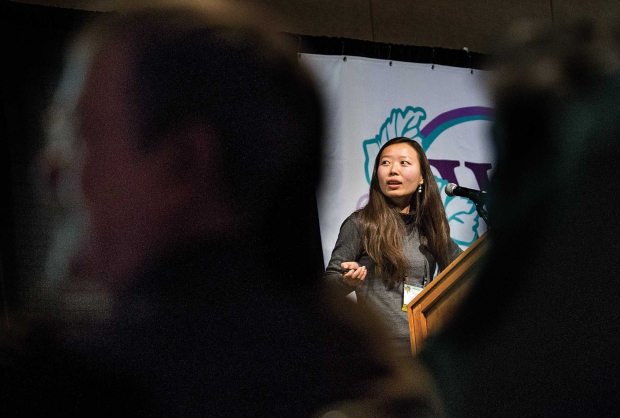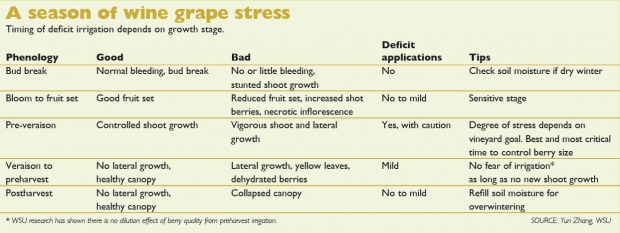
Yun Zhang of Washington State University says that grape growers can manipulate vine growth with deficit irrigation, but timing is critical to avoid severe water stress at the annual meeting of the Washington Association of Wine Grape Growers in 2014. (TJ Mullinax/Good Fruit Grower)
Wine grape growers in eastern Washington hold special power in their hands. By turning or not turning their irrigation valve, they can impose vine water stress to control vine vigor and berry growth.
The challenge is to apply the right amount without negatively impacting fruit quality.
In many wine regions, like Bordeaux, that receive more than 35 inches of rain annually, grapes are farmed without irrigation.
But in eastern Washington, with only seven to nine inches of precipitation annually, irrigation is needed.
Yun Zhang, postdoctoral research associate at Washington State University, said irrigation involves knowing how much to apply and when, how to measure vine water and soil moisture status, and how to manage water stress without negatively affecting vine growth and fruit quality.
“It’s a challenge for eastern Washington wine grape growers to understand all about irrigation,” Zhang said.
Monitor
When to irrigate depends on the vines’ water status and soil moisture. Growers should look for signs of stress in the vine to know when to irrigate, Zhang said during the annual meeting of the Washington Association of Wine Grape Growers.
Check tendrils, leaf orientation, and shoot tips to see if a vine is actively growing. Monitoring soil moisture is also important and can be done using neutron probes, capacitance sensors, tensiometers, and other tools.
Weather conditions also influence irrigation. Evapotranspiration is the combined loss of water through soil evaporation and vine transpiration. Low ET values are associated with cloudy, cool, or humid days when the vine and soil are not losing lots of water; high ET is associated with warm, sunny, dry, and windy conditions and long days.
Zhang noted that WSU’s AgWeatherNet weather stations collect and publish ET values, but warns that using such numbers solely can be problematic because they are not site specific or specific to wine grapes.
Vines receiving sufficient water will produce large canopies, but that’s not always a good thing in wine grapes.
Large canopies can result in too much shade in the fruit zone and reduce fruit set and cluster ripening. In areas with abundant soil moisture, growers often use hedging, shoot thinning, and leaf removal, to open up the canopy and improve light penetration.
Because soils in eastern Washington are quite dry, growers are able to use deficit irrigation techniques to their advantage to manipulate vine growth, Zhang said.
How much and when
“The fastest-growing tissues—flowers, shoot tips, and pre-veraison berries—are the most sensitive to water stress,” she said. “Because of that sensitivity, when you subject the vine to mild to moderate water stress, you can control shoot growth and berry enlargement. But you have to be careful to avoid severe water stress.”
Most wine grape growers in Washington follow regulated deficit irrigation, known as RDI, maintaining vine water status within a prescribed range of water stress for a defined part of the growing season. For red wine grape varieties, this means stressing the vines from fruit set to veraison.
But she warns that the water stress needs to be removed after the defined period, and vines should then be irrigated to 100 percent ET. “If the soil is not fully refilled after this period and the stress removed, the vines may be vulnerable to heat stress later in the season.”
Partial root zone drying is another deficit irrigation method. PRD involves alternately irrigating different sides of the vine, spatially separating the root zone. Vine roots are exposed to dry and wet soil, with each side alternately irrigated usually every 5 to 14 days, depending on the site and weather.
The vine reacts to water stress on the dry side by slowing vegetative growth, but the wet side helps maintain the vine.
It works best in deep, sandy loam soils, she said. The main disadvantage is that it requires separate drip irrigation lines on each side of the vine. Advantages are that partial root zone drying is more flexible in the timing of irrigation and more forgiving if irrigation is late compared to RDI.
While growers must match their irrigation strategies with their goals, Zhang believes there may be a place in Washington for PRD, depending on variety and wine styles.
For red cultivars like Cabernet Sauvignon, Merlot, and Syrah, where small berries, deep color, and concentrated flavors are sought, RDI is beneficial. But for aromatic white varieties—Chardonnay, Riesling, and Sauvignon Blanc—less sun exposure is desired than in the reds and PRD may work better, she said. “Partial root zone drying can give good tonnage without sacrificing quality.”
Growers can use deficit irrigation in the vineyard to manipulate wine styles, she said, adding that growing a variety like Sauvignon Blanc in a dense canopy can result in more herbaceous characters, if that is the desired goal.
Good and bad
Deficit irrigation, when done properly, can improve grape quality, Zhang said.
Deficit irrigation benefits include substantial savings in irrigation water, limiting unnecessary shoot growth, manipulating berry size, and modifying wine style in the vineyard. Having a more open canopy sets off a chain of positive events—better fruit exposure and air circulation in the fruit zone leads to reduced disease pressure and improved fruit quality.
But bad things can happen if the vine is stressed at the wrong time or stressed too much.
In early spring, insufficient water in the soil profile before bud break can result in poor and delayed bud break and stunted shoot growth. If winters are dry and bleeding sap is not observed in the vineyard when soil temperature has reached 50°F, it’s a good indication that soils are dry and irrigation is needed.
“Too much stress before fruit set can result in poor fruit set and even necrotic inflorescence,” she said, adding that stress before veraison is the best time to influence berry size. “Too much stress at veraison can result in yellow leaves, early defoliation, and cause potassium to recycle from the leaves to berries and increase juice potassium and pH.”
Another critical time is after veraison as harvest nears. Too much stress after veraison and preharvest can dehydrate berries, result in sunburned grapes, and reduce yields, she noted.
In the postharvest stage, the vine needs to harden off for winter. The canopy should be healthy, but not vigorously growing. “Growers should refill the soil moisture for overwintering,” she said. •







Leave A Comment